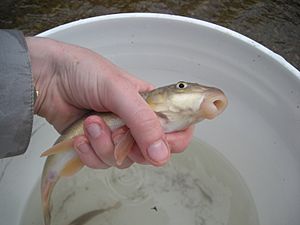Sonora sucker facts for kids
Quick facts for kids Sonora sucker |
|
|---|---|
 |
|
| Conservation status | |
| Scientific classification |
The Sonora Sucker is a type of fish. It is also known as the Gila Sucker. Its scientific name is Catostomus insignis. This fish is medium-sized. It belongs to a group of fish called catostomids. There are 16 other kinds of suckers in its family. These fish are found across North America. The Sonora Sucker looks a lot like the Yaqui Sucker.
Contents
About the Sonora Sucker
Sonora Suckers have a body shape like a torpedo. This means they are wider in the middle and narrower at the ends. They have big heads and look a bit chubby. Their lower lips are usually large. These lips do not have any extra fleshy parts.
The Sonora Sucker has special dorsal fins. These fins are on their back and look square. They also have fairly large scales. However, they have fewer scales than most other fish in their group. Their color is clearly two-toned. Their underside is yellow. Their top side is brownish. Each scale has clear edges. This makes a distinct spot on each scale. Adult Sonora Suckers can grow up to 80 centimeters (31.5 inches) long. They can weigh about 2 kilograms (4.4 pounds).
Where Sonora Suckers Live
The Sonora Sucker mostly lives in New Mexico and Arizona. You can also find them in northern Sonora, Mexico. These fish are very common in the Gila and Bill Williams river basins in Arizona. They are also often found in the Gila and San Francisco river systems in New Mexico.
Sonora Sucker Homes
Sonora Suckers can live in many different places. They can be found in cool trout streams. They also live in warm water rivers. However, these fish prefer certain spots. They like rocky areas. They also prefer water that is fairly deep and calm. During the day, adult Sonora Suckers often hide. They like to stay in shady spots.
What Sonora Suckers Eat
The main food for Sonora Suckers is tiny creatures. They eat small crustaceans. These are like tiny shrimp. They also eat protozoans. These are very tiny single-celled organisms. And they eat macroinvertebrates. These are small animals without backbones. Adult fish eat both plants and animals. They feed in the early morning and late evening.
Life Cycle and Reproduction
During the breeding season, two male Sonora Suckers usually follow one female. The females lay their eggs in "riffles." Riffles are shallow areas in a stream with small waves or ripples. The eggs are kept safe in the spaces between gravel. Females usually lay their eggs in smaller streams. Only a few will lay eggs in lakes. Spawning starts in late winter. It continues until the middle of summer.
Sonora Sucker Behavior
Sonora Suckers are often described as very calm fish. They do not move around much. This is true even during big changes in seasons or large floods. However, there is one area where they are rarely seen. This is in the Salt River Canyon. This is because many flathead catfish live there. Flathead catfish eat Sonora Suckers.
Protecting Sonora Suckers
Building large dams and lakes, called reservoirs, has reduced the places where Sonora Suckers can live. Too much sand in streams also harms their homes. This sand comes from soil washing away from the land.
Two groups in Arizona are working to protect these fish. They are the Arizona Game and Fish Departments. They are studying the fish in two rivers. These are the Lower Salt and Lower Verde Rivers. The studies help them understand how many fish there are. They also help them create plans to manage and protect the Sonora Sucker.
See also
 In Spanish: Catostomus insignis para niños
In Spanish: Catostomus insignis para niños


